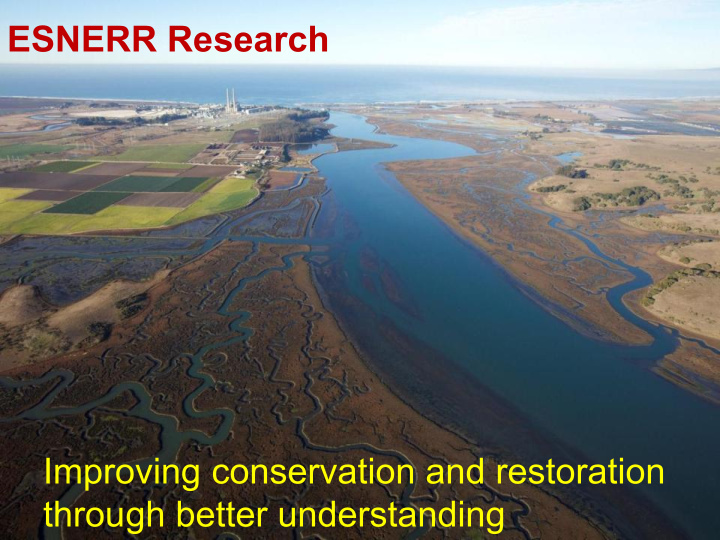



Current research highlights ESNERR Research • Oysters (Kerstin) • Ecotone (Kerstin) • Marsh (Rikke & Charlie) • Hypoxia (John & Rikke) • Eucalyptus (Susie) Improving conservation and restoration through better understanding
WATER QUALITY MONITORING AND TRENDS ESNERR water quality monitoring Spatial program since monthly 1989 (24 sites) Temporal program every 15 mins since 1995 (4 sites) WQ report card was tri-fold had out now interactive on website Recent summary of Spatial program 30 yr long term trends study
ESNERR Water Quality Monitoring
ESNERR WQ MONITORING PROGRAMS Volunteer Program Great spatial coverage (24 stations) Monthly sampling Very long time series (since 1989) Physical Parameters and nutrients
ESNERR WQ MONITORING PROGRAMS AP Volunteer Program NM Great spatial coverage (24 stations) SM Monthly sampling VM Very long time series (since 1989) Physical Parameters and nutrients NERR Program Great temporal coverage (every 15 min!) 4 stations Since 1995
NERR SYSTEM-WIDE MONITORING PROGRAM WQ DATA COLLECTED CONSISTENTLY AT FOUR STATIONS AT 28 NERR SITES
WATER QUALITY INDEX GRADING SYSTEM Canadian Water Quality Index (WQI) Created by the Canadian Council of Ministers of the Environment in 2001 Widely used: peer-review journals, UN, Bay Institute, Ventura County, CCAMP
HOW DOES IT WORK? ALL COMES DOWN TO THRESHOLDS Parameter Threshold Ammonia 0.1 mg/L Ammonia (Unionized) 0.025 mg/L Algal Cover 20% Chlorophyll a 15 µ g/L Nitrate as N 1.0 mg/L Orthophosphate as P 0.13 mg/L Turbidity 25 NTU Dissolved Oxygen 7 to 13 mg/L pH 7 to 8.5
Normalizing each component to scale to 100
GRADING SCALE Index Value Condition Grade Description 95 – 100 Excellent A No virtual threat or impairment. Water quality conditions very close to natural or pristine levels. 80 – 94 Good B Only minor degree of threat or impairment. Water quality conditions rarely depart form natural or desirable levels. 65 – 79 Fair C Occasionally threatened or impaired. Water quality conditions sometimes depart form natural or desirable levels. 45 – 64 Marginal D Frequently threatened or impaired. Water quality conditions often depart from natural or desirable levels. 0 – 44 Poor F Almost always threatened or impaired. Water quality conditions usually depart from natural or desirable levels.
2013 RESULTS Upper Elkhorn Slough 1 Carneros Creek* 34 F 2 Blohm Porter Marsh* 43 F 3 Hudson Landing 51 D 4 Azevedo Pond, North* 74 C 5 Azevedo Pond, Central* 46 D 6 Azevedo Pond, South* 43 F 7 Kirby Park 67 C 8 Reserve North Marsh* 67 C 9 Strawberry Rd* 22 F Lower Elkhorn Slough 10 Whistlestop Lagoon* 73 C 11 South Marsh 80 B 12 Vierra 80 B 13 Skipper's Landing 72 C Bennett Slough 14 Bennett Slough West* 66 C 15 Bennett Slough East* 50 D 16 Struve Pond* 43 F Southern Estuary 17 Moss Landing Road, North 44 F 18 Moss Landing Road, South* 27 F 19 Moro Cojo Slough* 32 F 20 Potrero Road, North 34 F 21 Potrero Road, South* 30 F 22 Monterey Dunes Way* 36 F 23 Tembladero Slough* 21 F 24 Salinas River Bridge 37 F * Site behind water control structure
FINAL PRODUCT Includes a summary of: Elkhorn Slough ecological importance Water quality monitoring program Grading system Results Ways to improve water quality
NOW THE FINAL PRODUCT IS ON THE WEB!
Our new display in the Visitor Center Coming Soon! • Dedicated touch screen • Visitors can interact with the report card and do their own research! • Individual curiosity to investigate areas, parameters or years of interest • Currently High School module to learn about water quality and do their own investigations as to why some areas get better scores than others
30 TRENDS STUDY OF SPATIAL PROGRAM
HIGHLIGHTS OF THE STUDY · Variability was not generally correlated to weather or oceanography, suggesting that local factors have strong and rapid effects on wetland water quality · Water quality remains highly impaired at many sites, especially those with artificial tidal restriction resulting in increased residence times
LOCAL RESTORATION IMPROVES WATER QUALITY The significant improvements documented in regions with high conservation and restoration investments provide hope for the future, and illustrate that, despite the potential for slow response times due to legacy effects from nutrient enrichment, water quality can be improved relatively quickly when resources are appropriately directed
Numeric Letter Ammonia Nitrate Phosphate Grade Grade · Overall water r 30.1 F 1 + --- ns quality is improving with Upper r 46 F 2 ns ns -- Slough significant improvements 3 ns --- --- 61 D r in water quality over 60.4 D 4 --- --- --- Azevedo r 41.8 F 5 --- --- --- time outnumbering r 30.4 F 6 --- --- ns significant deterioration 7 --- --- --- 73.1 C in water quality, for 25 r 70 C 8 +++ ++ ns Middle r 23.4 F 9 ns --- ns sites and three nutrient Slough 10 -- --- --- 76.7 C water quality 11 --- --- --- 76.9 C r 39.9 F parameters 16 --- -- --- r 44.6 D Bennett 15 --- --- --- The Middle and Upper Slough r 14 ns ns ns r 66 C regions of Elkhorn Slough 25 ++ ns --- Lower 12 + ++ -- 78.6 C highest frequency of Slough 13 ++ ns - 73.7 C water quality r 35 F 19 ns ns ++ Moro Cojo r 37.3 F 18 ++ ns + improvements, while the Slough 17 ns +++ ns 57.5 D Lower region of Elkhorn r 30.2 F 24 ns ns +++ Slough, highest r 25.5 F 23 --- +++ --- South r 27.2 F 22 --- ns ns frequency of water Estuary r 32.1 F 21 - +++ ns quality deterioration 20 ns +++ + 34.9 F
Recommend
More recommend